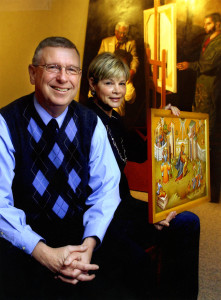Fear Less, Trust More: Instructions for How to See
 Dr. Larry Gerbens has been helping people see for a lifetime. It’s his gift. As a physician and founder of Grand Rapids Ophthalmology, the connection to sight is obvious. But it’s his second career, as a gift officer and mentor for pre-med/pre-health students at Calvin College, where he’s providing new views. At 60-something, looking back on his life and career, there were plenty of times when he was unsure or challenged. But overall he says that he would fear less and trust more. Here are his perspectives:
Dr. Larry Gerbens has been helping people see for a lifetime. It’s his gift. As a physician and founder of Grand Rapids Ophthalmology, the connection to sight is obvious. But it’s his second career, as a gift officer and mentor for pre-med/pre-health students at Calvin College, where he’s providing new views. At 60-something, looking back on his life and career, there were plenty of times when he was unsure or challenged. But overall he says that he would fear less and trust more. Here are his perspectives:
- Work Hard. Larry’s dad was a custodian and he worked hard to support the family. His influence was critical to Larry’s worldview. He used to always say, “Don’t be afraid of a little hard work.” He had pride in doing a job well and in doing good for his family. He also used to say, “If it’s worth doing, it’s worth doing well.” Larry has lived these truisms by putting hard work into his education, his family, his business, and his work with college students.
- Accept Help from the Community. In the context of all his success including building the largest ophthalmology practice in the state and raising a happy family, it is surprising to learn that Larry actually quit U of M med school in his third year. It was key members of his community who helped him pull things back together and stay the course. There was the doctor who found a way to give him a one year leave of absence and the doctor who told him there was a place in medicine for him, among others. They helped him find his way back, complete med school, and chart his right path.
- Don’t Take Shortcuts. Larry and his business partners were committed to hiring the best and serving their patients. Sometimes this stretched their resources, but as their business grew, it became the characteristic that set them apart from other practices. “Hire the very best people you can find, and set them free,” he says.
- Learn as You Go. Year-by-year, GR Ophthalmology grew, and the team’s openness to expanding their reach helped ensure this growth. They didn’t know every single thing they needed to run the business when they started, but they learned with each new step – of adding physicians, of adding locations, of working through ever-changing governmental restrictions. Larry himself became expert at pediatric surgery, a high-risk and critically important specialty.
- Invest Your Heart. Larry’s family went to their cottage on Big Star Lake every weekend – this was part of Larry’s way to integrate work and life – making room for all of it. Every Sunday night though, they would come home early so Larry would have time to prepare for the pediatric surgery. Each Monday, Larry would have surgery with another child, and he needed Sunday nights to review charts, mentally prepare, and focus for the emotional investment he would make beginning every Monday morning.
- Take Your Family Along. Larry has three children and one of the ways he integrated work and life was to take his family along on his trips overseas. Living in Sierra Leone for a summer was an example. Whether they were mission trips or vacations, Larry took his wife and their three children along. While some people avoided taking their families – it was admittedly a lot of effort – Larry believes it was worth every moment. He attributes the children’s openness and acceptance of others to their time living, working, and visiting other countries.
- Seek Joy. Larry says that he and his wife Mary have always given a lot of their time, talent, and treasure, but sometimes they gave because they knew it was the thing to do. Now, from his current perspective, he urges that we give based on what gives us joy. He says it’s not just about success in the traditional sense of the word, but also about significance*. The decisions we make about how we spend our time and where we give should be born out of a sense of the impact we want to have on others – on our legacy.
- Bring Your Identity. Larry credits Jeff Manion** with fresh ideas about identity. He says that instead of gaining identity from our possessions or our careers, we should bring our identity to them. For Larry, identity comes from who we belong to, Christ, not from what belongs to us. Instead of getting identity from a career, bring identity to a career.
- Live Grace and Forgiveness. Larry and his wife Mary have the largest art collection associated with the story of the prodigal son. Through the stress and intensity of running his practice and the significant impact he was making on his patients, art was a place of respite. The story of the prodigal son resonated with Larry and his wife because it speaks deeply of grace and forgiveness. It is important for them to share the collection with others and as a result, they have donated it to their alma mater, Calvin College.
- Never Stop Giving. Larry’s retirement isn’t retirement at all. He has launched this second career as a gift officer and mentor to students at the behest of friends and family. In the opportunity, he is inspired (“I love this work. The days fly by.”) and inspiring. In addition to securing gifts for the college, he connects students with community resources and contacts, coaches them on getting into med school, and provides a listening ear as they navigate through heady decisions about their futures. The students he mentors are at the dawns of their careers. Larry is too. He’s only just begun to live into this second phase of significance.
Frederick Buechner, a writer and theologian said, “The place God calls you to, is the place where your deep gladness and the world’s deep hunger meet.” Surely this is part of Larry’s legacy and how he helps people see.
*Larry has enjoyed the book called ‘From Success to Significance’ by Lloyd Reeb.
**Jeff Manion is the pastor at Ada Bible Church and the author of ‘Satisfied’ and ‘The Land Between’.
Photos are used with permission.
Would you like to tell your story? If so, let me know by emailing me at tbrower108@gmail.com. Why? One of the foundations of Bringing Work to Life is abundance: the idea that it is possible to find fulfillment, have it all, and avoid the trade-offs between work and life. After all, work and life aren’t separate things to be placed in containers, but part of an integrated whole of a satisfying life. Another foundation of Bringing Work to Life is the idea of multiple right answers. As we’re all seeking ways to bring work to life – and bring life to work – we can learn from each other’s unique solutions and stories. I’d love to learn about your story!
Tracy Brower is the author of Bring Work to Life by Bringing Life to Work: A Guide for Leaders and Organizations.
